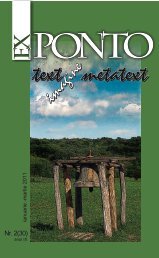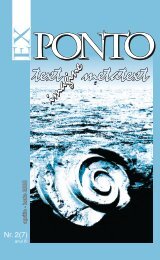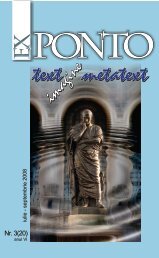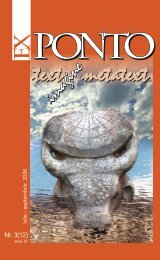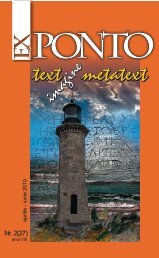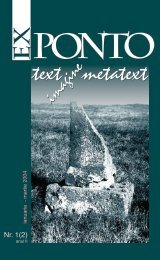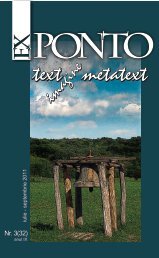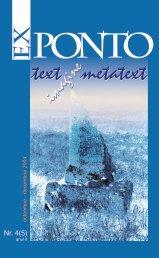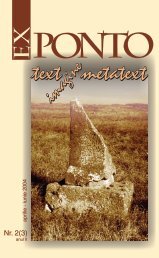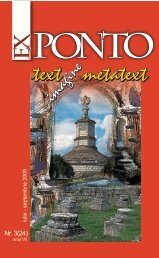Nr. 2 (19) anul VI / aprilie-iunie 2008 - ROMDIDAC
Nr. 2 (19) anul VI / aprilie-iunie 2008 - ROMDIDAC
Nr. 2 (19) anul VI / aprilie-iunie 2008 - ROMDIDAC
Create successful ePaper yourself
Turn your PDF publications into a flip-book with our unique Google optimized e-Paper software.
of resistance against the system. The consumption of such works substituted<br />
for real protest.<br />
The following caricatures present the quality that the communist system<br />
feared most: the successful combination of wit, innocence, and authentic<br />
laughter in the face of the even tragic situation. The wit is circumstantial<br />
and dated; once it is explained, it rewards the<br />
reader/viewer. In Suicide Line, Stanescu targets<br />
the Romanians’ obedience and the system’s<br />
deliberate suppression of joy by forcing people<br />
to live at the level of immediate necessity with no<br />
reason for living like soulless tools.<br />
On the other hand, he laughs at the so-called<br />
volunteer activities and at the necessity to stand<br />
in line for the most necessary items for survival.<br />
Volunteering and standing in line to commit suicide<br />
is so tragic in its meaninglessness that it becomes<br />
ridiculous when the character asks others to save<br />
her place in the other line not to take a chance on<br />
missing an opportunity!? Standing in line used to<br />
be the only way of getting things which<br />
were not rationed. What should have<br />
been the ultimate form of opposing<br />
the system becomes another way of<br />
playing by its rules. The one in which<br />
the danger sign has a schedule refers<br />
to the controlled blackouts which<br />
were frequent during that period.<br />
Again, even danger was something<br />
which people cannot take seriously<br />
and it thus becomes laughable.<br />
The theme of shortage is also<br />
explored in the caricature of the<br />
writers’ strike. The writers finally admitted that they had complaints but lacked<br />
the basic means with which to write them down. The scarcity of “materials” is<br />
also an implication of the further lack of subjects about which to write. Stanescu<br />
seems to ask the rhetorical question “what is the limit of the Romanians<br />
endurance” again and again. In comparing two<br />
parties, one from <strong>19</strong>79 and one from <strong>19</strong>89 he<br />
documented the degradation of intellectual life<br />
as a consequence of continuous worries about<br />
immediate needs.<br />
Ex Ponto nr.2, <strong>2008</strong><br />
166<br />
Stanescu’s caricatures present “the comic<br />
history of a tragedy” which “helped Romanians<br />
survive while in the middle of disaster,” as Andrei<br />
Plesu described Stanescu’s work. After <strong>19</strong>89<br />
when Romanians had a better idea about how<br />
the Secret Police worked, they understood that<br />
such mass phenomenon as the circulation of




